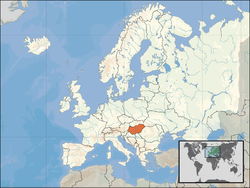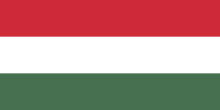Hungary

Hungary is a country in the south-eastern part of Central Europe. It shares borders with Slovakia, Ukraine, Romania, Serbia, Croatia, Slovenia and Austria. The capital city is Budapest. Other big cities in Hungary are Debrecen, Szeged and Miskolc. Hungary has been a member of the European Union since 2004 and uses the Forint as its currency.

Hungary's History[edit | edit source]
Hungary was founded in 1000 by István I (Stephen) as a kingdom. Croatia became a part of Hungary in the 12th century. The Mongols attacked Hungary in the 13th century. In 1301 the last king from the Árpád dynasty died and after that the kings came from several families. In 1526 the Turks conquered large parts of the country, after that the country split up into three parts called Royal Hungary, Transylvania and Ottoman Hungary. The king of Royal Hungary came from the Habsburg family, so it became a part of the Austrian Empire. Hungary was re-united in 1699. After that there were two big uprisings against the Habsburg kings: one from 1703-1711 and the other in 1848-1849. The first one was lead by Francis II Rákóczi and Sándor Petőfi the poet took part in the second one. People in Hungary are proud of them, a lot of streets and schools have their names. After World War I the Allied powers divided Hungary and gave the parts to the neighboring countries. Almost 3.5 million Hungarians became minorities mostly in Romania, Slovakia and Serbia. In World War II joined the Axis powers and took back some of these territories, but after the war lost them and the Soviets took control. In 1956 there was a revolt against the Communist government. In 1989 Hungary became a republic.

Dynasty — the family where the ruler of a country comes from

End of communism — In 1989 massive protests caused the end of Communism in many countries in central Europe including Hungary
Hungary's Geography[edit | edit source]
Hungary can be found in the Carpathian basin. Most of Hungary is flat but the Carpathian mountains in the northern part of the country reach a height of 1,014m at the Kékes mountain. The country is land-locked.
Hungary's People[edit | edit source]
Hungary has a population of about 10 million. Most of the population speaks Hungarian. Other spoken languages most common are English amongst the younger generation, and Russian amongst the older generation - though some refuse to use it due to the Communist connotations. Other languages include Slovakian, Romanian, Croatian, Ukrainian and German spoken in minority pockets at the relevant borders of those countries. Most of the Hungarian population are Christian (Catholic, Protestant and Orthodox). There are small numbers of Jews too.
Hungary's Sights[edit | edit source]


The city of Budapest is a UNESCO World Heritage Sites.
There are many things to see in Hungary. Within Budapest, the Országház (Parliament Building) is one of the most spectacular and famous Houses of Parliament in Europe. Opposite the Országház, is the Imperial Palace, the place of residence for the past rulers of Hungary. Mainly used during the Austrian occupation, it is a reminder of the country's turbulent history, along with Kossuth Tér, dedicated to the revolutionary Lajos Kossuth. Nearby is the everlasting flame - a fire that his been burning since the departure of the Communists in 1989. Also in the capital is the Basilica of St. István, the patron Saint of Hungary. Another highly recommended place to see is Hősök Tére (Heroes Square). It is a colonnade containing statues of all the kings of Hungary and in the centre is a column upon which St. István stands holding the Szent Korona (Saint's Crown).

Outside of the capital is the famous Lake Balaton. A favourite among the native population and tourists alike, the lake offers unparalleled a great beach-side holiday in a land-locked country. It is 14km wide and 75km long and can be seen from space. Lake-side towns of Siofok and Balatonfüred are popular tourist accommodations. A main cultural attraction at the lake is the peninsula of Tihany, hosting a Medieval Abbey which used to be a religious centre hundreds of years ago. Today, it is the mausoleum of Károly IV, the last King of Hungary. Inside is an exhibition dedicated to life inside the Abbey and also one about the King.
The town of Győr is famous in Hungary for its confectionery. "Győri" products are a common item seen on Hungarian supermarket shelves. The town itself boasts an impressive town hall as well as bank side walks along the Danube.
| Wikijunior Europe • Intro • EU • Geo • People • Language • Facts • Quiz | edit | ||
